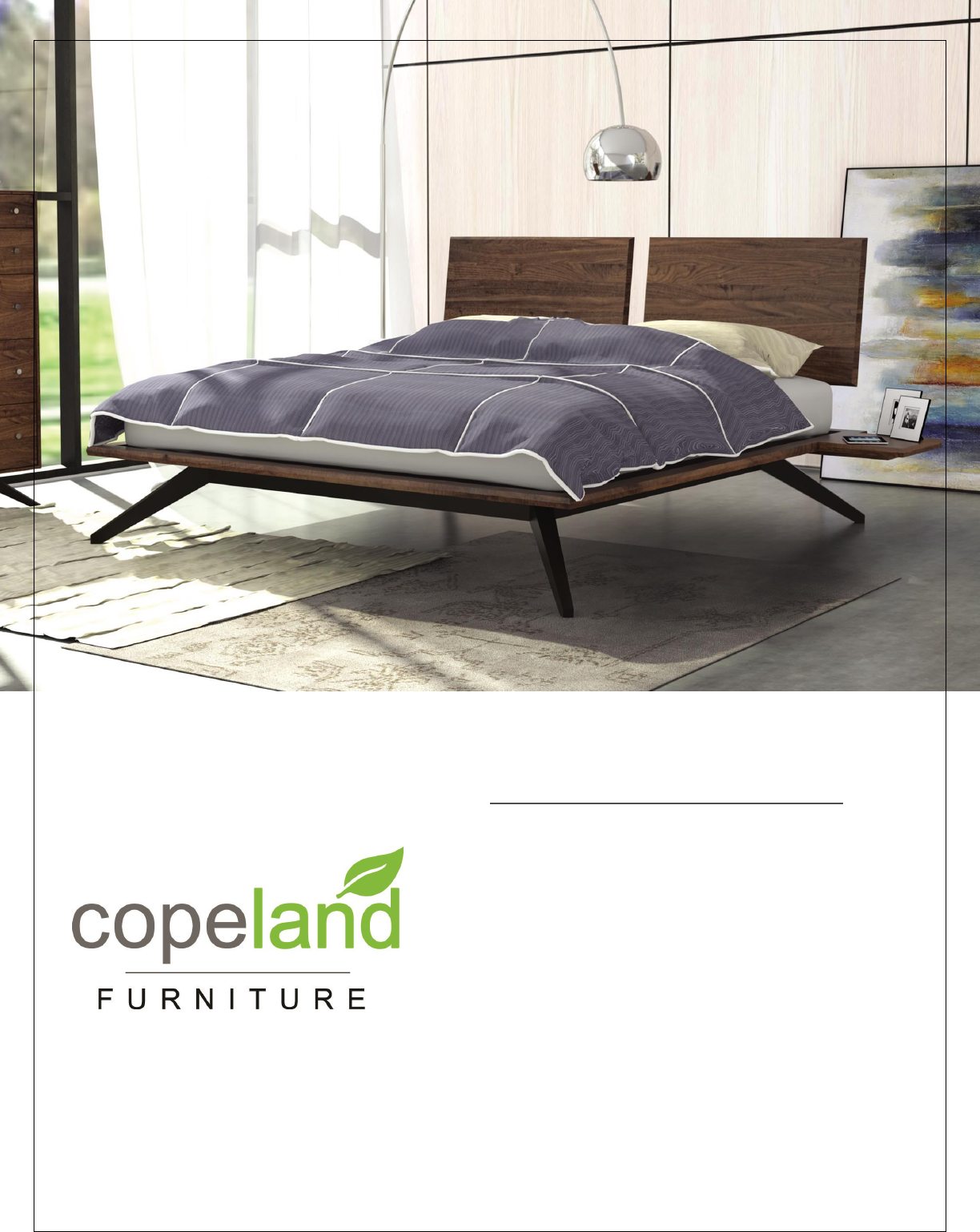
SALES ASSOCIATE TRAINING MANUAL;
CONTACT US:
In addition to your Copeland Furniture representative you
can receive specific, timely answers to any of your questions
from the following contacts.
Product Knowledge and Sales Related Questions:
BEN COPELAND
CELL PHONE: 802.291.0542
EMAIL: ben@copelandfurniture.com
Order Placement, Status and Shipping Questions:
JOANN THURSTON
PHONE - 802.222.9282 (Ext. 101)
EMAIL - joann@copelandfurniture.com
www.copelandfurniture.com
N A T U R A L H A R D W O O D F U R N I T U R E F R O M V E R M O N T
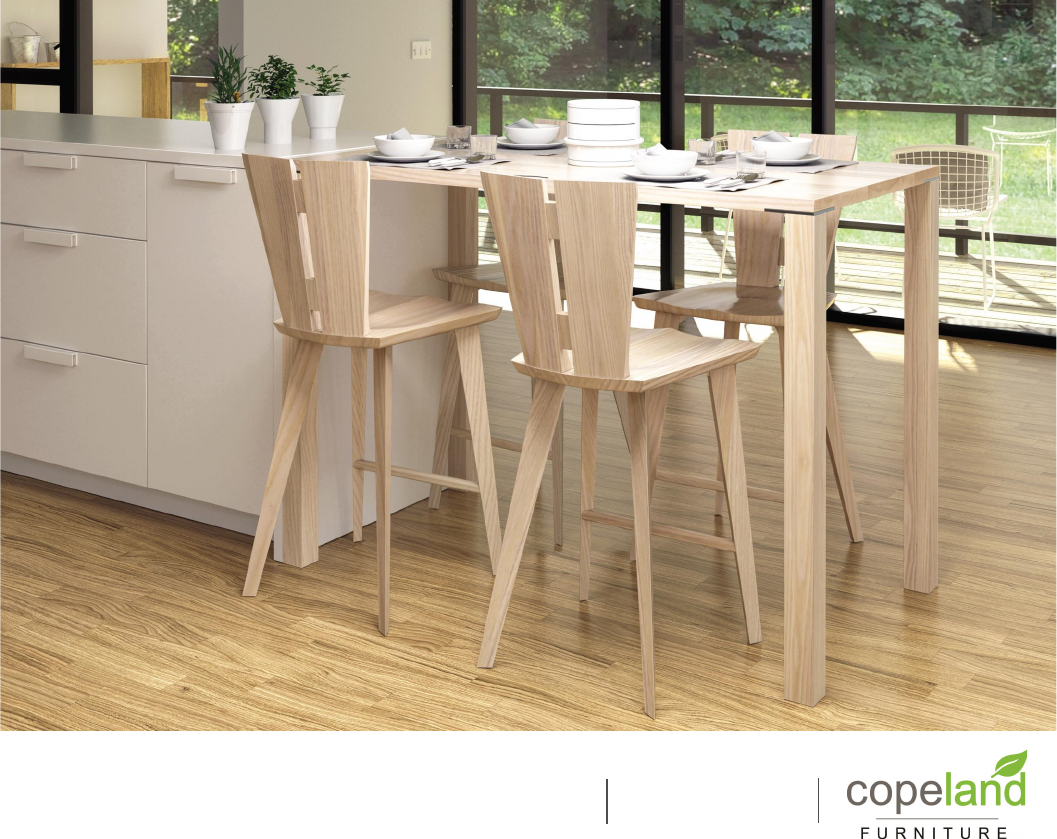
THE PURPOSE AND SCOPE OF THIS MANUAL
This document was created to provide our dealers and their sales associates answers to the most common
questions asked in the retail sales environment. It is designed to be used either as an in-depth sales training
syllabus or as a quick, at your fingertips, reference guide. The manual is regularly updated with the latest products
and developments so always refer to the most up to date edition. We have attempted to anticipate every common
scenario and arm you with all the product information, sales talking points and company background you’ll need to
make the Copeland Furniture line a valuable profit center in your establishment.
As important is to know where to go for answers to those unexpected or out of the ordinary questions. In addition to
your sales representative, please refer to the contacts listed on the first page of this manual and never hesitate to
call or write us at any time.
Please refer to this document as often as needed and don’t hesitate to offer suggestions on how it may be
improved. All the best to you and your organization.
Ben Copeland
COPELAND FURNITURE
2 May 2019

I N T R O D U C T I O N
Exclusivity and the High-End Consumer
Where consumer purchasing habits are concerned, high-end should be taken less as an mark of socio-
economic status and more as a mindset or value system. Individuals of all income backgrounds will
prioritize certain categories of products where their values are strongest - for some consumers it’s
automobiles, others it’s media content and others yet it’s home furnishings - and their purchases will
reflect those priorities. Regardless of the product type for which it manifests, the high-end mindset has
some common characteristics. It’s motivated less by concrete notions of quality and value than it is by
notions of relative superiority. Put another way, the high-end consumer doesn’t purchase products
because they are adequate for their needs, they purchase products because they are better than what
else is out there. This serves an emotional purpose for the consumer. Their purchases confirm that they
are knowledgeable, that they have a sophisticated level of taste, superior knowledge and even a greater
sense of social responsibility than the average consumer. In short, their purchases are a reflection of
how they view themselves.
Capturing the interest of this consumer means understanding your product in terms of design, material,
environmental impact, and construction and being able to effectively communicate its uniqueness to a
consumer who wants to know that they’ve found something exceptional.
The Nature of The Challenge
The furniture industry is different than those of most other high-end consumer products. Most industries
consist largely of a few dominant players with enormous marketing budgets that help shape consumer
perceptions and expectations (BMW, Mercedes, Rolex, Armani, Chanel, etc.) The home furnishings
industry, on the other hand, is made up of tens of thousands of manufacturers of all types and sizes, only
a small handful of which have generated any kind of top-of-mind brand awareness.
Consumers have a dizzying array of products to choose from and, as studies have shown, often find
furniture shopping to be a confusing and frustrating experience. Our consumers want quality but the
fractured nature of the industry means they don’t necessarily understand why two superficially similar
products can have wildly different prices. They want exclusivity but, not knowing what that actually is, are
fearful of being ripped-off. By helping customers to feel confident and well informed in their decisions, we
can make furniture shopping the self-affirming experience high-end consumers are seeking.
Then and Now - a Changing Paradigm in the Furniture Industry
Traditionally, the mark of high-end exclusivity in furniture was heavy carving and scrolling ornamentation.
Historically, these design elements were extremely labor intensive and costly, making them desired
markers of exclusivity as only the very wealthy could attain them. This is no longer the case. Injection
molding and an inexpensive global labor market has made ornate traditional design common across the
price spectrum. Increasingly, the marks of exclusivity are quality construction, high value raw materials
and Western labor (along with the implied Western values such as fair wages, product safety standards,
human rights and environmental responsibility).
This document is an exploration of these points and how they relate to our product. Through absorbing
and conveying this information to your customers we’re confident that you will have great success selling
our line of furniture.
3 May 2019
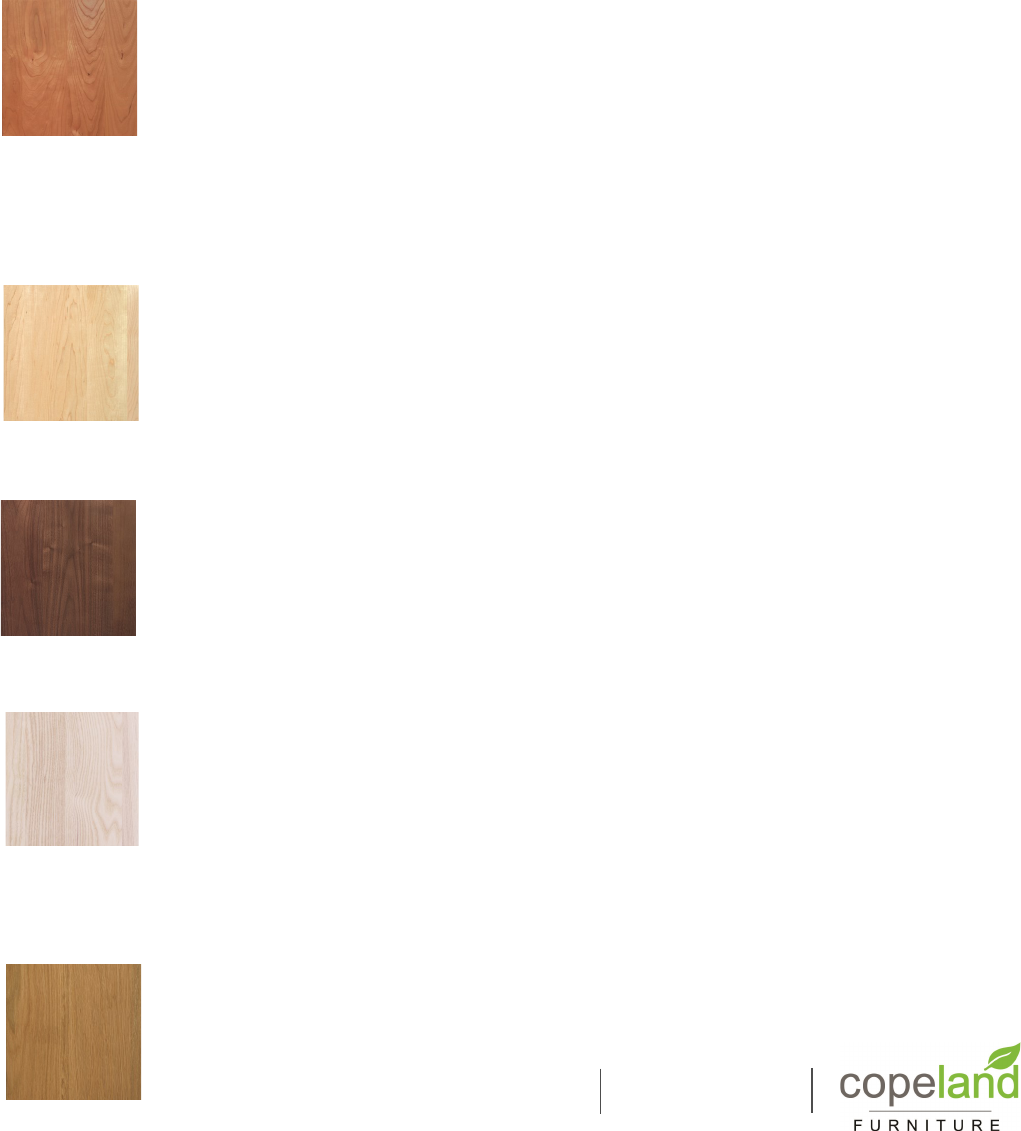
C O N S T R U C T I O N D E T A I L S
The Value of Solid, North American Hardwoods
High value raw materials – in this case North American Hardwoods such as Cherry, Maple, Walnut,
White Oak and Ash - are perhaps the only element that cannot be made cheaper through the global
labor or any economies of scale. Their value is what the marketplace determines it to be. Consumers
have always regarded these materials with high esteem and will pay a premium for solid wood. This is
not to argue that there is no place for veneered products but rather an acknowledgement that consumers
value these species for solid hardwoods as something with intrinsic value.
c h e r r y
Year after year consumer surveys find that cherry is the number one preferred wood
species. While most customers opt for natural cherry, the species is renowned among
woodworkers for its ability to accept stains beautifully. When a new piece of cherry furniture
arrives at your customers home it will be very light in color, almost like Maple or Birch. Its
color darkens with exposure to sunlight and in 3 to 6 months will have developed the rich,
reddish patina the species in known for.
Helpful Tip: Objects left on a piece of immature cherry will leave a lighter area where the wood is
hidden from direct light. Not to fear - these areas eventually even out leaving a consistent color across
the entire surface of the piece.
m a p l e
Maple is a heavy wood characterized by straight grain or clusters of curls (burls). It is
highly resistant to abrasion and indentation and the natural color ranges from cream to light
brown.
w a l n u t
American Black Walnut is a dense wood with a uniform to highly figured grain. The color
ranges from light gray-brown to dark purplish-brown. Walnut is America’s own exotic wood
species. It’s rich brown color comes, not from a stain but, from the wood’s natural
characteristics. This is evident in the subtle golden undertones that give a sense of warmth
and depth that could never be achieved with stains that blot out the entire surface of a
piece.
a s h
A member of the olive family, Ash exhibits open pores and pronounced graining.
Heartwood is a light to medium brown color while sapwood can comprise the majority of
the log, and is beige to light brown in color. Ash has excellent woodworking properties and
accepts stains well.
w h I t e o a k
Strong, attractive and rot-resistant, White Oak ranges in color from light to medium brown,
commonly with an olive cast. It is harder and has more figure than red oak, with a
distinctive open grain and coarse texture.
4 May 2019

Not All Solids are Created Equal
Another issue affecting the value of furniture is that of wood “grades.” Consumers often encounter
products made of solid Cherry or solid Walnut but that are only available in very dark stains that obscure
the natural character of the wood itself. This is usually because the manufacturer has specified a low
grade of lumber to save costs. Low grade lumber is often full of defects such as knots, extensive
undesirable sap wood, or even mildew stains which are then covered with dark stains.
Even more common is the use of inexpensive, less desirable species of wood (such as Poplar or Aspen)
and merely call the finish Cherry or Walnut. The stains used may be vaguely reddish or brown but have
none of the depth of real cherry or walnut and are simply an imitation of the real thing. Similarly, heavily
distressed, faux-antique finishes or painted effects usually indicate sub-premium materials.
While we offer stained finishes as an option for most wood species and collections, every group in the
line is available in a clear (or nearly clear) finish. Simply having that choice available is an indication that
the customer is receiving high grade, premium hardwood furniture.
The Behavior of Solid Wood
Wood is dynamic material. Some say that it is still “living” even after it is made into furniture. Unlike
composite materials and stone, it is constantly adapting to its environment and actually changing weight,
shape and size. For instance, a 42” wide table will easily change 3/8” of an inch in width over the course
of a year as the relative humidity in a living space varies with the seasons. Sometimes one surface of a
wooden component will receive a different exposure to seasonal changes than the other side and a slight
warping or “cupping” might occur. “Cupping” and warping are minimized by engineering the furniture so
that wide expanses of hardwood, such as table tops, are stabilized by other components that run across
the width of the panel and limit the extent to which the wider panel can move. We also retard variation in
moisture content with the application of moisture resistant Greengard finishes. While engineering
solutions can limit changes in shape they will never totally eliminate them.
Some interesting facts about solid hardwood furniture and how moisture and humidity effect it.
The hardwoods we use to make furniture have been dried to 6%-8% moisture content. The equalized
moisture content (EMC) of a typical living environment varies from a low of 4% to a high of 11%. This
change in environmental humidity impact the moisture content of everything in it. For example, when a
44” x 66” Catalina extension table leaves our factory it weighs about 120 lbs. Eight lbs, six ounces of that
is water. If exposed over a long enough term to the driest residential environment (heated air in a winter
climate) it will lose about 3 ½ lbs. of water. Exposed to a high humidity environment (un-air conditioned
beach house) it will gain 3 ½ lbs. It almost never reaches those extremes, because the driest and most
humid seasons usually only last for several months and moisture resistant finishes retards drying and
uptake of moisture.
Think of the cellular structure of wood as bundles of long narrow tubes. As the moisture content of the
cells is reduced the tube shrinks in width but not in length. With this variation in moisture content, solid
wood furniture, shrinks, expands and moves. The movement is small and happens slowly and often time
it is never noticed. For each 3% change in moisture content of finished wood the width of the wood will
change 1% in its width. That means that if we make a table 42” wide out of lumber that is 8% moisture
content, and it is left long enough in an environment with 11% EMC, it could expand by 3/8” in width. In a
dry environment with a 4% EMC, it could shrink by a little more than 3/8” of an inch. From one extreme to
the other, the change in width would be 3/4”.
5 May 2019

Solid wood glued panels
All solid wood panels in our line are made of color selected, kiln dried staves of wood that are arranged
in the optimal aesthetic configuration and bombarded with high intensity radio waves which cause the
glue to cure in about a minute. Staves are the individual longitudinal strips of wood that run the length of
the panel. They may vary in widths according to the specification of the part and item in question.
Finger joined vs. full length panels
Most parts in our line use staves that run the full length of a given panel - i.e. the full length of a case top,
or full length/width of a table top depending on grain direction. A smaller subset of our line and certain
secondary and tertiary parts use finger joined panels. These are panels where the staves are made of
shorter lengths of wood that are joined together at the ends to create a full stave.
Finger joined panels have varying specifications for color and character depending on their use and/or
the nature of the product. For example, Essentials tables are a value priced collection that make use of
shorter lengths of wood that have no utility for any full length panels. These tables are more inclusive of
sapwood and small voids than is so for the rest of our line. High grade finger joined panels are used in
some side rails and case sides. These panels specify full length end staves and a minimum length and
width for the shorts used to make the finger joined interior staves. Their color and void spec is identical to
that of full length panels.
Examples
Catalina Fixed Top Dining Table staves are made of
single strips of wood running the full length of the table top.
Small amounts of sapwood and voids (pin knots, pitch
pockets, mineral streaks, etc.) are allowed but are kept to a
minimum.
Catalina Buffet interior shelves, dividers and case
bottoms are made of finger joined interior staves with full
length staves at the panel ends. More in the way of color
variance and voids are allowed on these secondary and
interior surfaces.
Essentials Kidney Coffee Table uses falloff shorts from
regular production and is most inclusive of sapwood and
voids. No full length staves are used at the panel ends.
6 May 2019
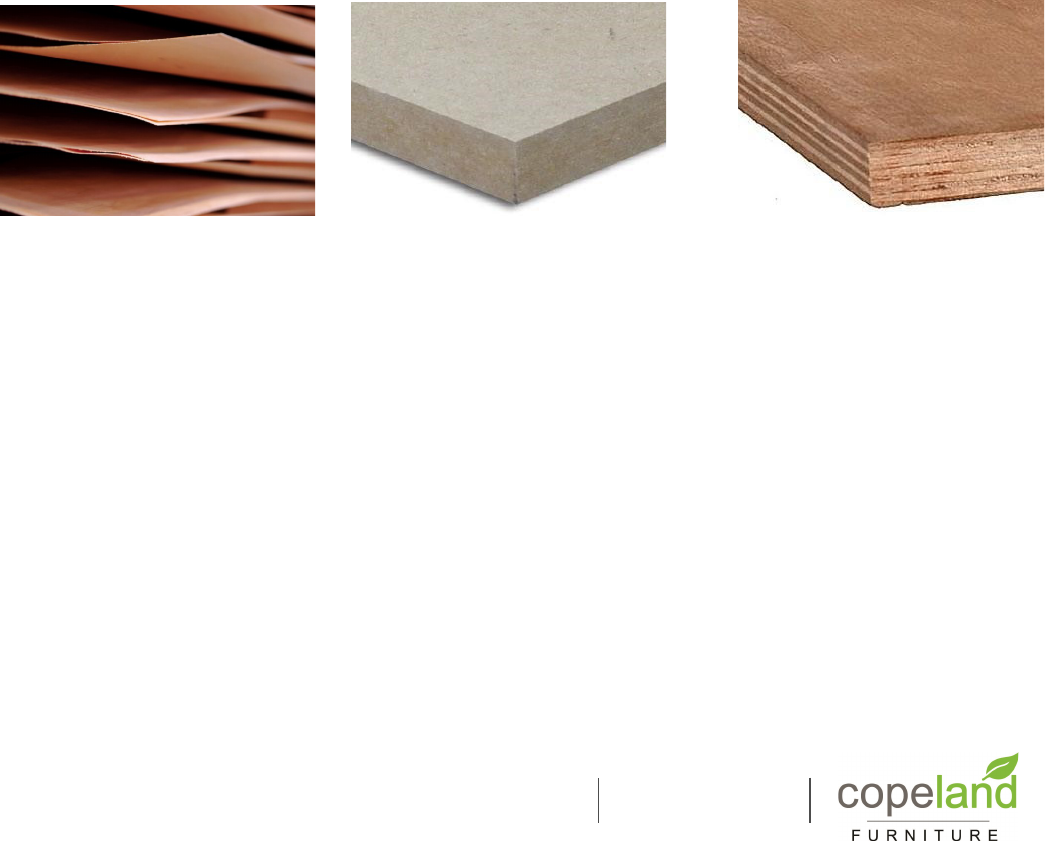
QUARTERSAWING (often referred to as Rift Sawing) - produces closely spaced, parallel graining.
Boards are then kiln dried to the ideal moisture content. Furniture made of solid wood must be engineered
deliberately to allow room for the wood to move. In this sense, the final shape of the product is largely dictated by
the properties of the materials themselves. This is an interesting variant of the modernist axiom form follows
function and could be expressed as form follows fabrication. In both cases the designer is subservient to
something other than their own internally derived sense of aesthetics (form follows fancy). The output of such a
design process almost unavoidably reads as timeless rather than the product of shifting fads.
The benefits of using solids are fairly obvious. Well made solid wood furniture is extremely durable and when
damaged can be repaired and renewed over generations – veneer over particle board, once damaged can never
be returned to “as good as new”. Solid wood construction is a time honored tradition that is also as much an
appeal to one’s sense of culture and heritage as it is to any practical criteria. Furniture built of solid wood often
displays exquisite, traditional joinery techniques that heighten a sense of historical connectedness even when the
style itself is Modern or contemporary.
VENEERS
A Veneer is a thinly cut overlay of solid wood applied over a substrate. Common furniture substrates include
Plywood, and Medium Density Fiberboard (MDF) or Particleboard .
VENEER SHEETS MDF PLYWOOD
There are three main reasons manufacturers use veneers in their products:
Reasons of Construction – complicated shapes and curves are often impossible to fabricate out of solids.
Very thin parts often require the strength of veneered plywood and certain design elements require the
dimensional stability of veneered components.
Reasons of Aesthetics - Interesting effects with wood grains can by achieved by matching and/or assembling
veneer strips in any number of deliberate patterns.
Reasons of Cost - Arguable the least credible but unquestionably the most common reason
manufacturers use veneers is that they simply cost less than solids. As the market price of cherry and walnut
rise, the cost of inexpensive MDF substrates can remain stable. With only a very thin strip of solid wood
covering the substrate companies can deliver a product that has the look of wood at a fraction of the cost.
7 May 2019
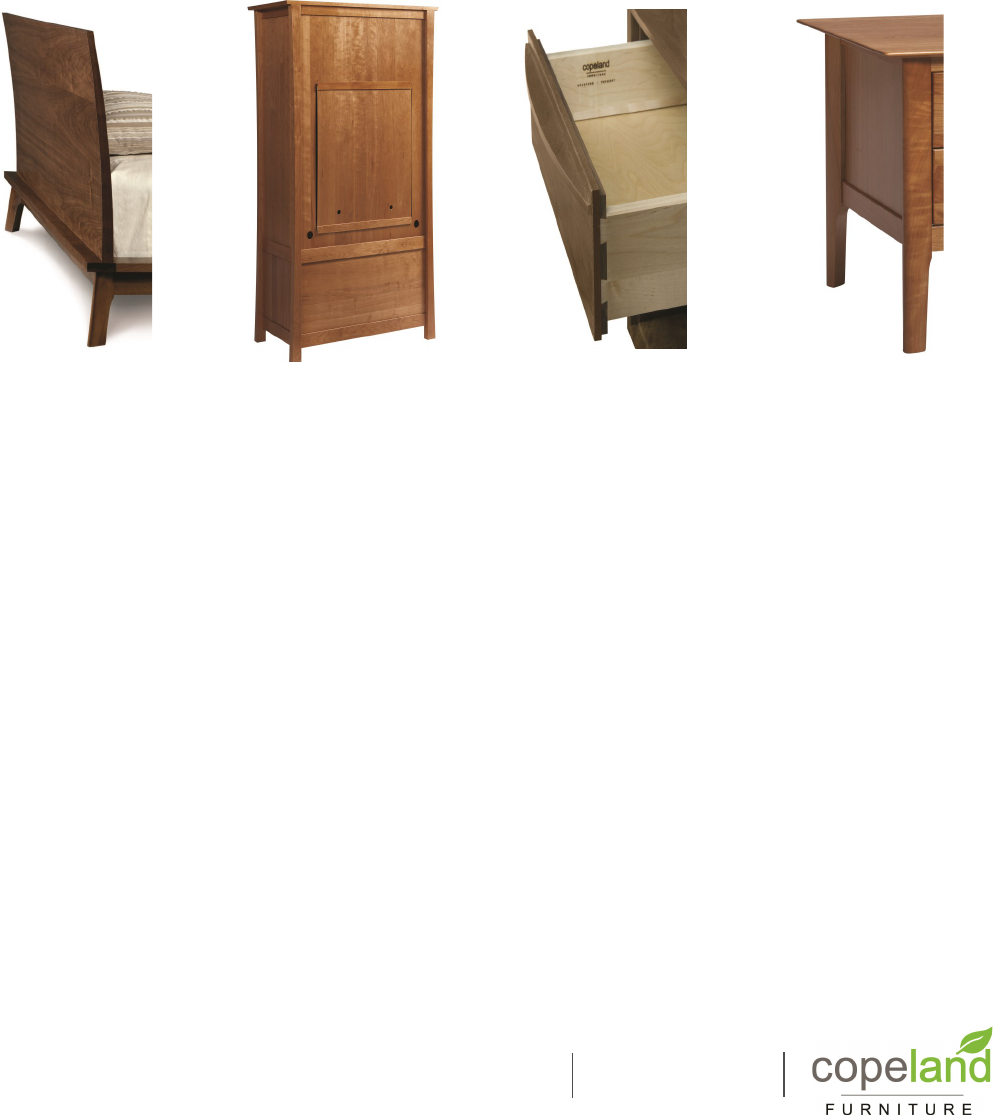
C O N S T R U C T I O N D E T A I L S
Solids vs. Veneers - continued ...where
Our reputation is as a solid wood specialist. This is not to say we never use veneers but rather that their
use is limited to the specific areas where they are the most appropriate choice rather than simply the
cheapest choice. For instance, the curved back panel of the Catalina Bed must be a veneer because it
would be structurally impossible to achieve this shape in solids. Framed panels, that is panels surrounded
on all four sides, will often be made of high grade, veneered plywood. In these instances, a panel made of
solids would have the potential to expand and break the frame apart during periods of high humidity. The
plywood is also considerably stronger than solids of equal dimension. This includes Case Backs and
Drawer Bottoms as well as Sarah and Berkeley/Monterey Case Sides.
How To Spot the Difference
This is an area that can even confound industry professionals. The technique of veneering wood is
centuries old and expert practitioners can execute their craft so seamlessly that it’s nearly impossible to
spot the cues. This has the potential to confuse and frustrate consumers. Often a customer who insists on
the quality of solid wood will be drawn to the very characteristics of a veneered product believing they are
buying solid. Here are some of the tells of veneering that you can offer to help educate your customers and
thereby avoid this frustration:
The Surface Looks Too Perfect - Wood is a natural, living product with irregularities in grain pattern,
variations in color and density and even small voids or indentations. These characteristics are unique in
each individual piece and are the desirable marks of solid wood construction. If the surface is
completely blemish free and 100% consistent then you may be looking at a veneer.
The Grain Pattern Repeats Itself - Often you will see a surface where the same arcing curves are
repeated - maybe only twice, maybe eight times or more. This is likely a veneer.
There is No Visible End Grain - Follow a surface with your eyes, parallel to the grain. When you
come to the end of a panel does the grain pattern and glue lines continue over the edge? If so you’re
looking at a solid. On the other hand, does the grain on the edge of the panel seem to be oriented in a
different direction with no evidence of any glue lines? That’s a veneer.
Of course, the most obvious tell may only become evident after years or months of use. Damage to
veneered furniture can sometimes result in de-lamination where the top veneer layer becomes separated
from the substrate. What may have only been a nick, scratch or ding in a piece of solid wood furniture can
have the effect of rendering a veneered piece useless - particularly if the damage has the effect of allowing
moisture to reach a MDF substrate.
8 May 2019
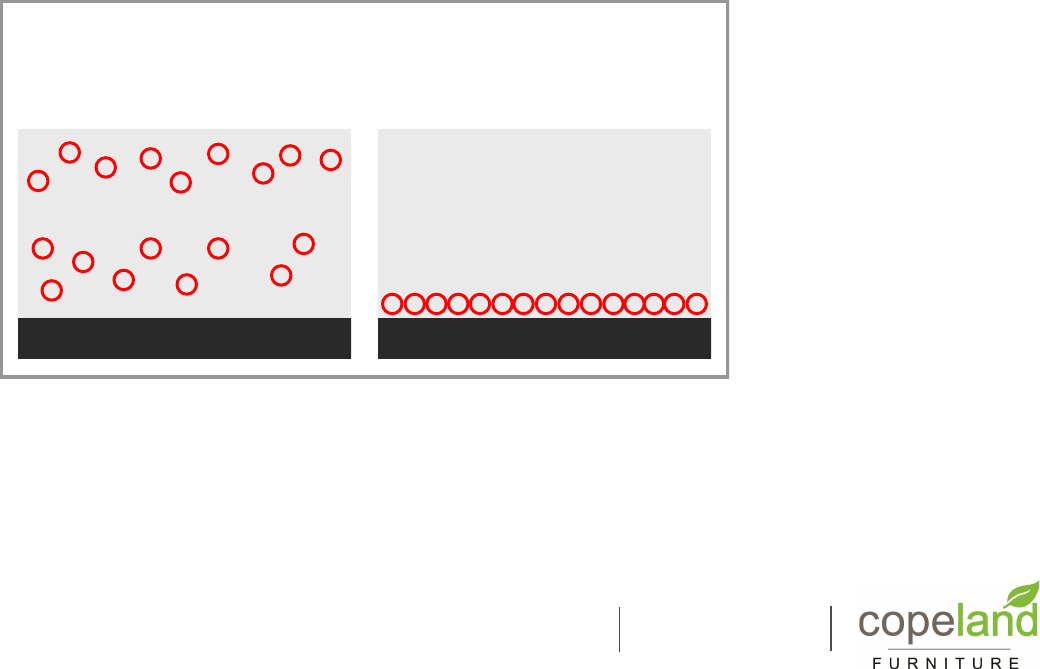
C O N S T R U C T I O N D E T A I L S
The Finish (top coats) - to protect and beautify
To preserve order and continuity, the discussion here will be limited to top coats. You can refer to the finish
options section of our catalog for information on stains and color.
While there are several processes and types of finishes possible, the overwhelming majority of wood finishes
on the market can be understood by dividing them into two basic groups: Solvent Finishes and Oil and Wax
finishes. Each of these types has their own set of advantages, benefits and limitations:
Oil and Wax
This two part finish begins with a coat of oil (often boiled linseed oil) which penetrates the surface of the wood,
offering a degree of protection and highlighting the wood’s natural color. After drying the piece may then
receive one or more coat of wax which is buffed into the desired degree of glossiness. Oil and Wax finishes
have the two main advantages - natural beauty and ease of application. For the manufacturer these finishes
require very little overhead investment in the way of special equipment or processing. They can be applied as
easily by an individual in his home as they can by a factory producing millions of dollars of merchandise a
year. As such, Oil and Wax also has some appeal as the preferred choice of traditional craftsmen. The
principle limitation of Oil and Wax finishes is durability. They provide relatively little protection from scratches
and dings and are extremely susceptible to water damage.
Solvent Finishes
This is a general term that applies to any number of finish types including Varnishes, Lacquers, Shellacs and
Paints. In this type of finish a solid component or resin is carried to the product by a liquid solvent. As
the finish cures the solvent evaporates and a solid film of resin settles on the surface of the piece. This creates
a hard, protective coat that is durable and, depending on the properties of the finish, can offer aesthetic
enhancements as well. In the furniture industry, the majority of all clear top coats are some form of lacquer.
The term lacquer implies that the resin is derived from Nitrocellulose fibers and can be subdivided into two
main subgroups: Conventional and Catalyzed.
Conventional Lacquers provide durable albeit not superior protection. If there is such a thing as a
furniture industry standard, conventional lacquers are it. Manufacturers opt for these finishes due to their
relative ease of application and
their highly forgiving nature.
Typically a manufacturer will apply
many layers of finish until they
have built up a thick coating which
can then be buffed into a high
gloss. The resin is soft enough that
it takes easily to this process. This
allows the manufacturer to take
fewer precautions with regard to
airborne dust in the factory and
runs in the finish. They know that
errors of this nature can be easily
repaired with buffing.
The limitations of conventional lacquers are: only moderate protection and a somewhat artificial look and feel.
Compared to their catalyzed relatives, conventional lacquers offer limited durability and protection. They are
comparatively soft and susceptible to water damage. The required thick buildup can also make a surface seem
to be synthetic or ‘plastic’. Depending on the raw materials used to build the furniture this may not be a
problem however with solid wood customers have the expectation that the finish look and feel as natural as
possible.
Wood Surface Wood Surface
Resin - Suspended in Solvent
Cured Finish
Conventional Lacquer
1
2
The finish is spray applied to the
surface of the piece.
As the finish cures, the solvent
evaporates leaving a hard,
protective coat on the surface.
9 May 2019
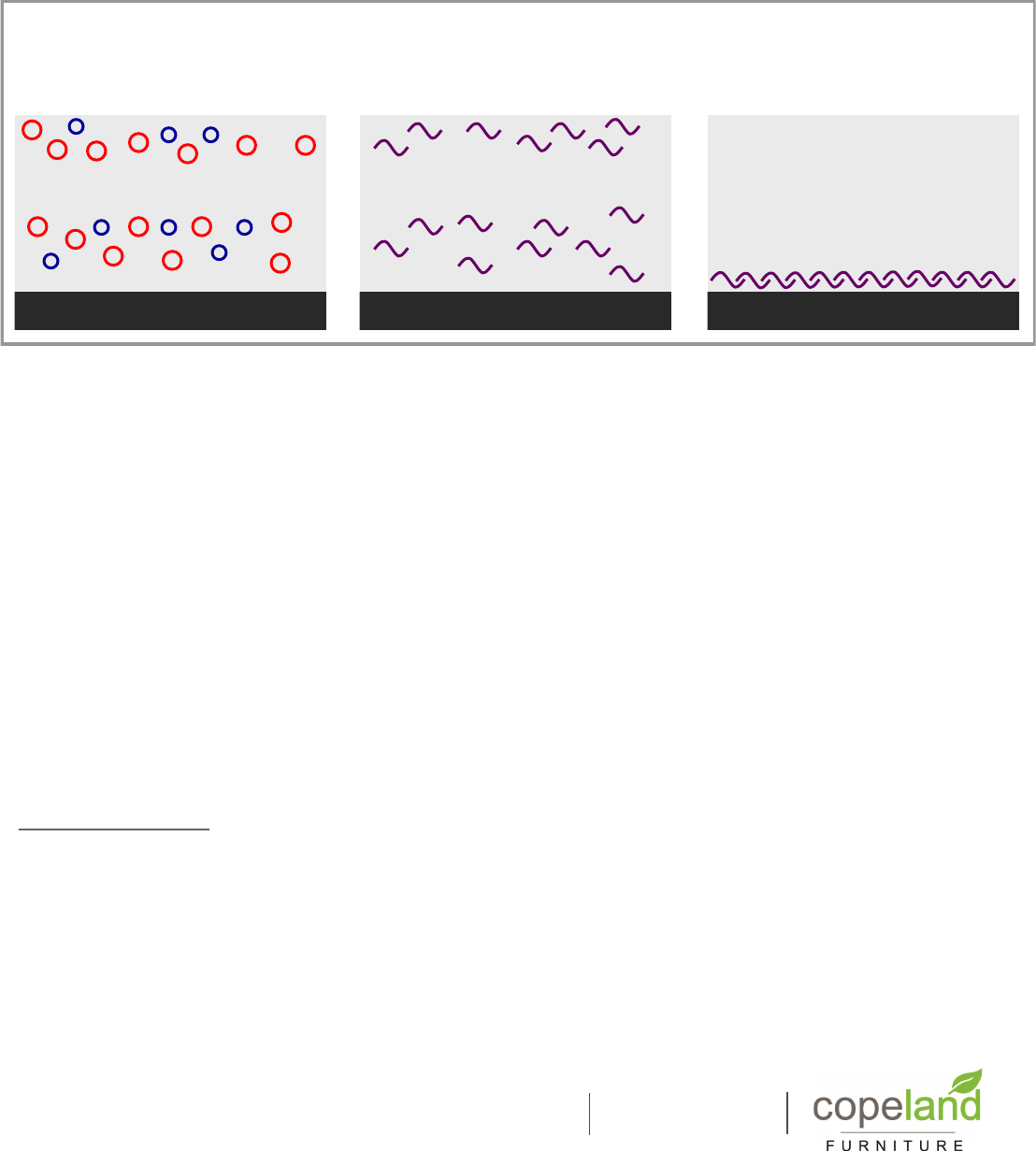
Wood Surface Wood Surface
Altered Resin
Suspended in Solvent
Cured Finish
Wood Surface
Resin and Catalyst
Suspended in Solvent
1
2
3
The finish is spray applied to the
surface of the piece.
The catalyst reacts with the resin,
altering its properties
As the finish cures the altered resins
cross-link, forming tighter bonds than
conventional solvent finishes
Catalyzed Lacquers
C O N S T R U C T I O N D E T A I L S
Catalyzed Lacquers are known as “reactive” finishes, meaning an acidic additive acts as a catalyst, causing
resins to cross-link upon curing. This creates a much more durable and moisture-resistant coating than with non-
catalyzed finishes. Because they are so much harder than conventional lacquers, they can be applied with only
a few thin coats resulting in the most natural look and feel possible.
The Copeland Furniture Finish
Our standard Copeland Furniture top-coats are catalyzed. Our finishes are Kitchen Cabinet Manufacturers
Association (KCMA) rated - meaning they are made to withstand the type of heat, grease and spills typically
found in a kitchen setting. This durability is a significant advantage over the industry’s standard conventional
lacquers. Also noteworthy is the matte, satin look and feel of our finish which contrasts favorably with the heavy
build-up and high gloss of conventional finishes..
GREENGUARD Certification
As the public’s concern over indoor air quality continues to grow, it’s important that you have a response to your
customers’ concerns. Most solvents finishes contain small amounts of formaldehyde and other toxic chemicals
that can off-gas in the home. Individuals with particular sensitivities sometimes report that this has an adverse
affect on their health.
We use finishes that are GREENGUARD Certified for low chemical emissions as the standard option on all of
our products. GREENGUARD certification is a testing program of UL (Underwriters Laboratory) focusing on the
issue of indoor air quality. Further information about GREENGUARD certification, can be found at:
www.greenguard.org
Helpful Sales Tip: As you explain the advantages and benefits of one finish over another, have your
customer run their hand over a surface pointing out the soft, satin feel. Explain how this is only possible if the
finish is durable enough to provide superior protection without a thick build up. For many years our dealers
associates have had great success with this simple tactile demonstration.
10 May 2019
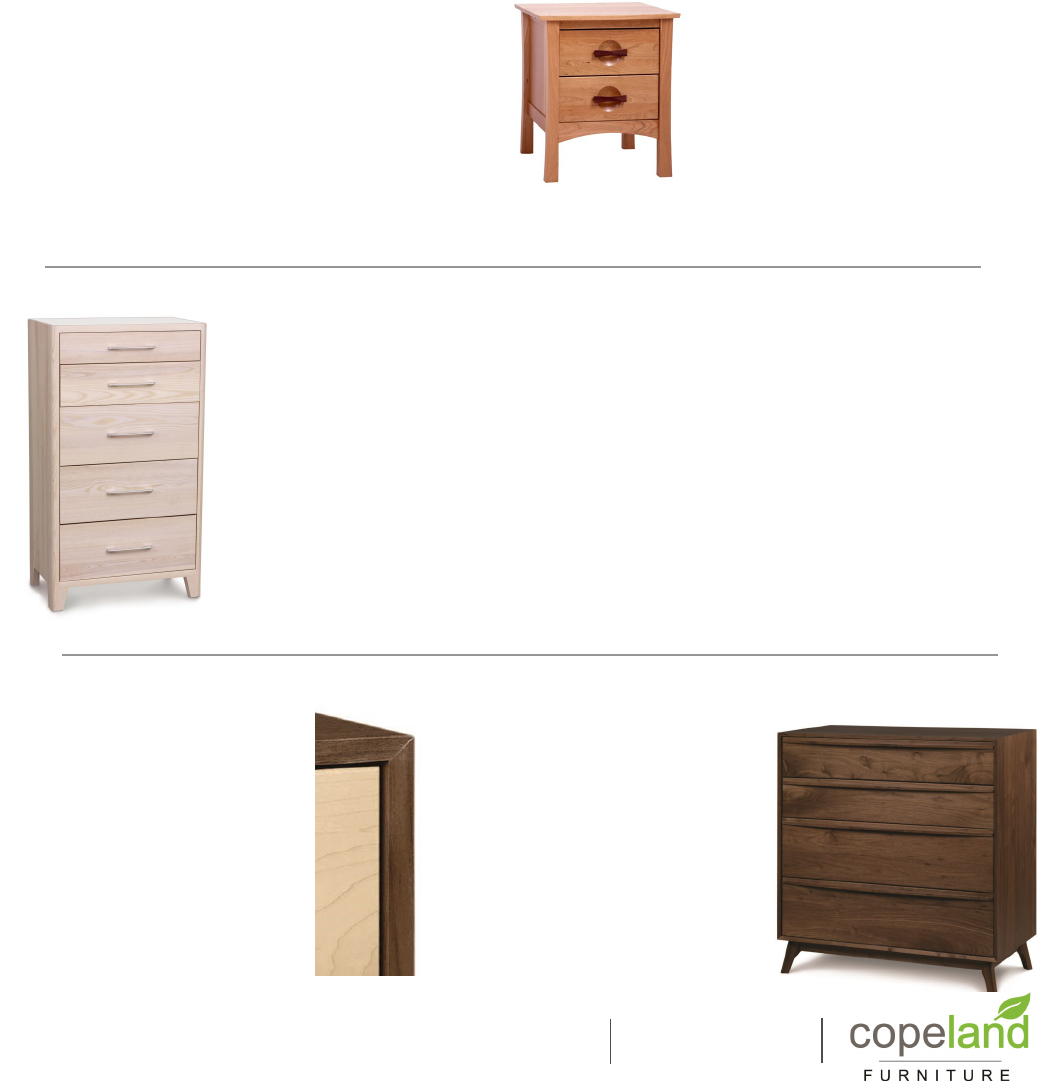
C O N S T R U C T I O N D E T A I L S
Joinery Techniques - Bringing it all Together
Over and over, customers say they are drawn to our furniture because of how solid it feels. This is because the
nature of the raw materials themselves has, in many ways, dictated design and construction. Tight fitting,
precision milled joints are a absolute must with solid wood furniture in a way that is not always the case with
veneers. These techniques and choices often result in visual interest and character that customers desire and
respond to.
Case Types
Our line can be understood by examining the various types of case architecture we use to create different
collections.
Frame and Panel cases derive their main structure
from the four legs which are joined by an apron
assembly near the top and bottom of the case. These
parts make up the frame. A solid wood top is affixed and
1/4” top-grade veneer panels are integrated into the
case sides and back. Because the panels are framed on
all four sides this, a veneer is the ideal material. Were
we to use a solid panel the expansion of the wood in
high humidity could potentially cause the frame to break
apart.
Solid Side construction means that the main vertical
structural members are the 3/4” solid wood side panels.
Contour case tops may be ordered in either wood or opal
laminated glass.
Solid side groups may be made of either Cherry, Walnut or
Ash.
Forty-five Degree Miter
construction refers to the angle in
which solid wood tops and sides
are joined to create a perfectly
seamless perimeter. Stylistically,
these cases are highly refined and
visually Modern. The technique to
produce this style of case requires
extreme precision and is only
attainable through exacting detail.
The leading edge of the cases is
beveled to present a thin delicate,
line that belies their considerable
heft.
Frame and Panel Collections
Berkeley Bedroom
Monterey Bedroom
Sarah Bedroom
Sarah Home Office
Solid Side Collections
In Ash
Contour
In Walnut
Contour
Exeter Buffets
In Cherry
Exeter Buffets
Sarah Dining Cases
Forty-Five Degree Miter Collections
Astrid Bedroom
Audrey Dining
Catalina Home
Keaton Bedroom
Linear Office
Mansfield Bedroom
Moduluxe Bedroom
MiMo Storage
Rizma Bedroom
Sloane Bedroom
SoHo Bedroom
11 May 2019
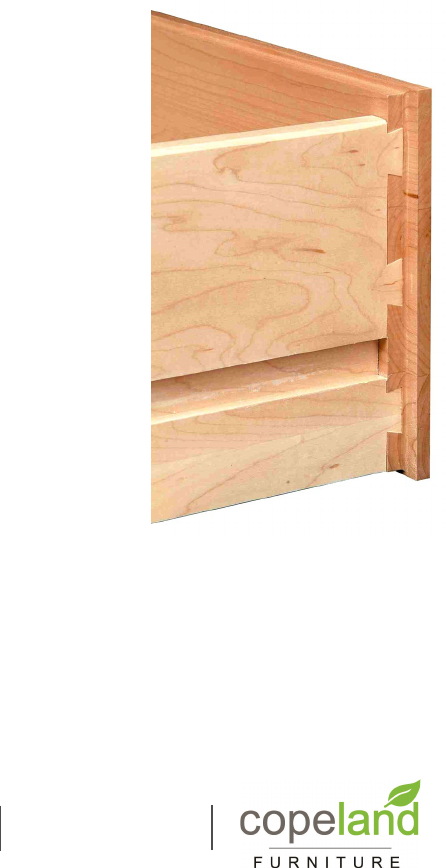
C O N S T R U C T I O N D E T A I L S
Joinery Techniques - continued
Furniture shoppers everywhere can be observed using a fairly standard battery of tests to determine the
quality of a piece of furniture. This is similar to opening and slamming the doors of a new car to judge how
solid an automobile feels. The customer may not know everything about cars but a heavy door that makes a
firm sound when slammed feels like quality. As the thinking goes, the level of care evident in the surface
elements, such as the doors, is probably the same throughout the vehicle. Knowing these sets of tests and
how our product stacks up against competitors will be an advantage in your sales efforts.
Drawer Boxes
This may be the number one test customers apply to a case piece. This is probably because drawer
construction is the first area where many manufacturers will try to cut costs. Many opt for significantly thinner
interior parts (some using drawer sides and backs as thin as 3/8”) as well as sub-grade materials such as
poplar, rough grade plywood or veneered MDF. Our drawer fronts are
solid wood, 3/4” thick. Drawer sides and backs are also solid wood
- cherry, maple or ash - and are a full 5/8” thick. Drawer bottoms are
1/4” high-grade plywood panels.
You’ll notice that our drawers are joined with what’s called an
asymmetrical English dovetail joint. Asymmetrical refers to the
fact that the pins (seen on the drawer front) and tails (seen on the
drawer side) are of different widths. This is the gold standard in
traditional joinery and is both aesthetically and structurally superior to
other common techniques.
Another thing to notice is that the drawer front integrates directly with
the drawer side. Often you will find furniture where the drawer front is
simply screwed on to a pre-existing drawer box. This is usually
because the manufacturer has opted to purchase pre-manufactured
drawer boxes rather than going to the trouble of designing, engineering
and building the components to match their individual designs. Sadly,
many manufacturers who market themselves as Made in the USA
engage in this practice, effectively outsourcing components that make
up nearly half of the product.
The final area some manufacturers cut corners is in leaving drawer
boxes unfinished. Not only is this unsightly, it is potentially hazardous
to your customers clothing. Delicate garments can be snagged or even
torn on rough unsanded surfaces. This becomes more pronounced
with age or as the unprotected wood is exposed to changing humidity.
Our drawer boxes are fully finished and sanded on the interiors.
Helpful Sales Tip: There are few elements that can communicate
quality like a well constructed drawer box. Offer to take a drawer
completely out of it’s case and let the customer feel the solid construction and heft of the piece. This is another
‘field-tested’ technique that sales associates have been successful with for years.
12 May 2019
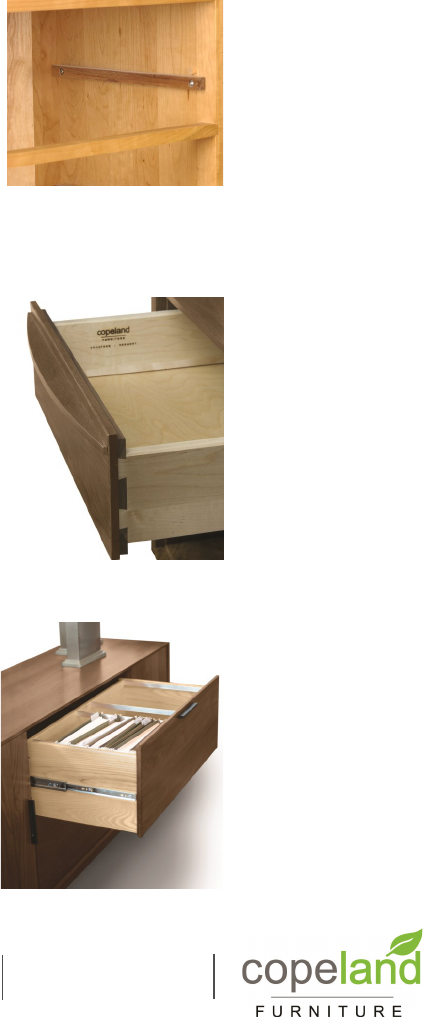
C O N S T R U C T I O N D E T A I L S
Joinery Techniques - tests of quality
Drawer Glides
Equally important to how the drawer is put together is how it functions. Is there a lot of “play” from side to side
or up and down? Does it open and close smoothly or with great friction? Some customers will test the drawers
of every piece they look at until they find the feel of quality they’re looking for. Our glide mechanisms can be
divided into two categories: Wood on Wood and Ball Bearing glides
Wood on Wood Glides
These are the traditional cabinet makers standard. Some
consumers expect wood on wood as a sign of authenticity in
their solid wood furniture.
Adjustable wood glides are a unique Copeland Furniture
innovation. Two glides on either side of the drawer are spring
loaded and attached to the case side with two Philips head
screws. They can then be adjusted tighter or looser to allow for
the perfect fit and smooth operation.
Ball Bearing Glides
Depending on their function and design, some groups call for a
more high-tech glide mechanism. It’s important to note that not
all metal glides are created equal. Epoxy Coated Wheel Glides
(the white glides you see mounted to the sides of drawers) sell
for less than a dollar a set and have a lifetime that matches the
price. You will never find a set of these on our furniture.
Our modern collections use an Under Mounted Soft Close
glide. These glides provide a gentle bump as the drawer is
fully extended and a soft automatic retraction as the drawer
closes. Since they are under mounted there is no visible
hardware.
All home office collections feature Full Extension File Glides.
These allow drawers to open wide enough for easy access to
all contents and are strong enough to support the heavy load
associated with office storage. File cabinets also feature an
anti tip mechanism that allows only one file drawer to be
opened at a time. These glides may also be used on items
where oversized drawers or intended use requires greater
load bearing capabilities such as storage bed drawers.
Wood on Wood Glides
Berkeley
Monterey
Sarah
Under Mounted Soft Close:
Astrid
Audrey
Catalina (bedroom,
dining, media)
Contour
Exeter Dining
Keaton
Mansfield
MiMo
Moduluxe
Rizma
Sloane
SoHo
Full Extension File Glides:
Catalina Home Office
Keyboard Trays and File
drawers (all collections)
Linear Home Office
Sarah Home Office
Storage Beds (all collec-
tions)
13 May 2019
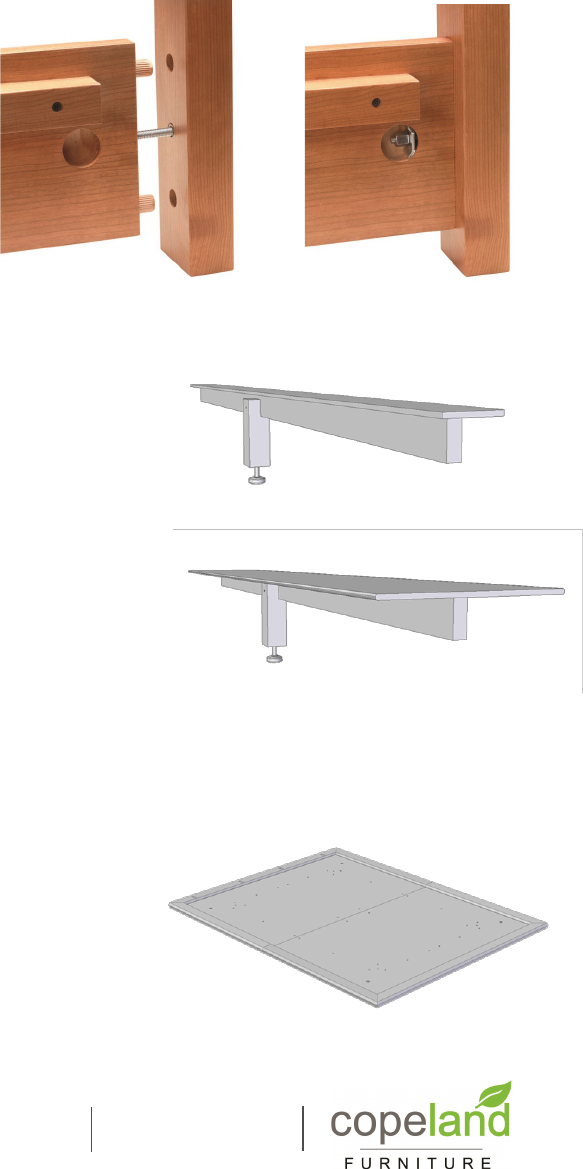
C O N S T R U C T I O N D E T A I L S
Joinery Techniques - tests of quality
Bed Rails
All Copeland Furniture bed rails are fastened with a simple to use but extremely durable system designed to
keep the joint firm and rigid for the life of the product. Here’s how it works:
1. A headless, threaded machine bolt is screwed
into the headboard. Wooden dowel pegs align
the bed rail with the headboard or footboard.
This forces the bed rail into proper orientation
and prevents any future twisting.
2. The parts are then joined together with a
special contoured washer and hex nut using the
supplied open-end wrench.
Bed Slats and Platforms
Mattress support may come in one of three forms depending on the collection: T-Slats, Platforms Kit , Solid
Deck.
A T-Slat is a 3” plywood slat reinforced by a solid hardwood spine.
Viewed from the side, the parts form the shape of a T, hence the
name. T-Slats always come in packages of three and are standard
on beds requiring box spring and mattress.
Platform Kits are similar to T-Slats in that they consist of a
plywood horizontal element reinforced by a solid wood spine.
However they differ in that they are much wider and are intended to
provide the direct support for the mattress. They come in sets of six
platforms and are standard on all beds intended for mattress alone
(minus those mentioned in the section titled Solid Deck).
For both systems above, mattress supports are attached to wooden
cleats on the side rails using, supplied, Philips head screws. Note:
some beds may be ordered in either T-slat or Platform Kit
configurations depending on the consumers preference.
Solid Deck construction is unique to Astrid, Contour and
Moduluxe (plinth version) beds and consists of two 3/4” Baltic Birch
plywood panels that create a rigid foundation capable of supporting
the beds’ highly cantilevered platform.
All beds include adjustable center support legs that assure a level
sleeping surface as well as compliance with standard mattress
warrantees.
1. 2.
14 May 2019
